▼ Chile - Home to world's largest telescope [05-29-17]
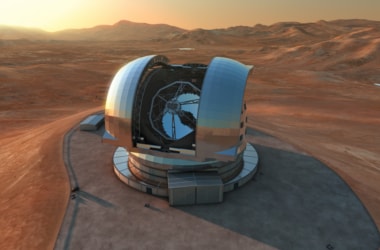 Construction works for building Extremely Large Telescope (ELT) has commenced in Chile. Construction works for building Extremely Large Telescope (ELT) has commenced in Chile.
After completion, the Extremely Large Telescope will become the world’s largest optical telescope which will be five times larger than the top observing instruments that are in use today.
The telescope will be constructed at a 3,000 meter-high mountain in the middle of the Atacama desert.
The telescope is scheduled to commence its operations in 2024.
The ELT is funded by the European Southern Observatory. The organization comprises of European and southern hemisphere nations. It is expected that construction costs of ELT would come around 1 billion euros at 2012 prices.
The main mirror of the ELT will measure some 39 meters (43 yards) across. This massive size of the mirror will be of immense use to expand the understanding of the universe.
The telescope will enhance the ability of astronomers to find more smaller planets, image larger ones, and possibly characterize their atmospheres.
These capabilities will be key in understanding if life is present in those planets or not.
The dry atmosphere of the Atacama desert offers perfect observing conditions one can find on Earth. No wonder around 70% of the world’s astronomical infrastructure are slated to be built in the Atacama desert by the 2020s.
European Southern Observatory: Know More
- Established in 1962.
- European Southern Observatory is a 16 nation intergovernmental research organization for ground based astronomy.
- Its observatories are situated in Chile.
- It has built and operated many technologically advanced telescopes like New Technology Telescope, Very Large Telescope (VLT), Atacama Large Millimetre Array etc.
|
▼ Shala tree phytochemical bergenin used for curing TB [05-29-17]
 A team of Indian researchers achieved a 100-fold reduction in tuberculosis bacteria load in lungs of mice after 60 days of treatment using bergenin. A team of Indian researchers achieved a 100-fold reduction in tuberculosis bacteria load in lungs of mice after 60 days of treatment using bergenin.
Bergenin is a phytochemical isolated from tender leaves of sakhua or shala tree (Shorea robusta). Unlike the regularly used antibiotic drugs that target the TB bacteria, the bergenin compound modulates the immune system to kill the bacteria found inside the macrophages, which is a type of white blood cells.
The study conducted by the Indian researchers show that the bergenin compound can be used to clear the bacteria.
In fact, when it is used in combination with other TB drugs, the compound can produce good results.
The researchers undertook several studies to understand the mode of action of the compound.
The compound was unable to directly kill tuberculosis bacteria when treated with the compound.
However, in the case of in vitro studies, the compound was able to kill the bacteria found inside infected cells.
In mice infected with TB and treated with the compound, there was significant reduction in the bacterial load in the lungs.
Unlike in the case of in vitro studies, in mice the compound was found to activate not only the macrophages but also other cell types (T cells) that led to effective killing of the bacteria.
A significant reduction in the number of granulomatic lesions was seen in animals treated with the compound.
Also, the bacterial load was 100-fold lower in mice treated with the compound compared with animals that were not treated with bergenin.
The bergenin compound was selectively enhancing the frequency of interferon-gamma and interleukin-17-producing T cells in the TB infected animals.
Interferon-gamma promotes bacteria-killing nitric oxide inside macrophages thus promoting the generation of protective immune responses against tuberculosis bacteria.
The compound can be used in patients with drug-resistant TB too, as it does not target the bacteria directly but modulates the immune system to kill the bacteria.
|
▼ NASA-ISRO collaboration for NISAR [05-25-17]
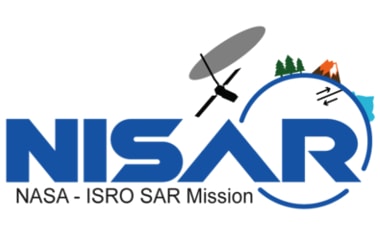 The Indian Space Research Organisation (ISRO) and the National Aeronautics and Space Administration (NASA) have collaborated to make an Earth-imaging satellite called NISAR. The Indian Space Research Organisation (ISRO) and the National Aeronautics and Space Administration (NASA) have collaborated to make an Earth-imaging satellite called NISAR.
The satellite will help scientists monitor the Earth like never before.
The expanded form of NISAR is NASA-ISRO Synthetic Aperture Radar.
It is scheduled to be launched in 2021.
The estimated cost of the radar is over 1.5 billion dollars and it could possibly be the world’s most expensive Earth imaging satellite.
The two documents to launch the NASA-ISRO satellite mission were signed.
The aim of the mission is to observe Earth and establish a pathway for future joint missions for Mars exploration.
The NASA-ISRO Synthetic Aperture Radar will provide an unprecedented detailed view of Earth by using advanced radar imaging.
The satellite is designed to observe and take measurements of some of the planet’s most complex processes, including ecosystem disturbances, ice-sheet collapse, and natural hazards such as earthquakes, tsunamis, volcanoes and landslides.
Under the terms of the agreement, NASA will provide the mission’s L-band synthetic aperture radar (SAR), a high-rate communication subsystem for science data, GPS receivers, a solid state recorder, and a payload data subsystem.
On the other hand, the ISRO will provide the satellite bus, an S-band synthetic aperture radar, the launch vehicle and associated launch services.
Data collected from the ambitious mission will unfold information about the evolution and state of Earth’s crust. It will also help scientists better understand our planet’s processes and changing climate, and aid future resource and hazard management.
The Earth-imaging satellite design will make use of a large deployable mesh antenna and will operate on dual L band and S band.
NISAR will be 3-axis stabilised and is planned to be launched into a Sun-synchronous dawn to dusk orbit with a mission life of 3 years.
NASA US Manned Programs: Know More
- Apollo Skylab Apollo–Soyuz Test Project (joint)
- Space Shuttle Shuttle–Mir (joint)
- ISS (joint)
- Mercury Gemini
- Manned Venus Flyby
- Manned Orbiting Laboratory
- Space Transportation System
- Orion Constellation
|
▼ First quasar map of universe! [05-24-17]
 Astronomers using the Sloan Digital Sky Survey (SDSS) have created the first map of the large-scale structure of the universe based entirely on the positions of quasars. Astronomers using the Sloan Digital Sky Survey (SDSS) have created the first map of the large-scale structure of the universe based entirely on the positions of quasars.
Quasars are incredibly bright and distant points of light.
The quasars are so bright that they can be seen all the way across the universe and that is what makes them the ideal objects to use to make the biggest map yet.
The extra brightness of the quasars is due to the super- massive black holes found at their centres.
As matter and energy fall into a quasars’ black hole, they heat up to incredibly high temperatures and begin to glow.
Scientists used the Sloan Foundation Telescope to observe the innumerable quasars in order to make the map.
During the first two years of the survey, astronomers measured accurate three-dimensional positions of more than 147,000 quasars.
The telescope observations gave the team the distances of the quasars, which were used to create a three-dimensional map of where the quasars are located.
Sloan Digital Sky Survey: Know More
- The survey known as Sloan Digital Sky Survey was extended to Baryon Oscillation Spectroscopic Survey (eBOSS) to better understand the expansion history of the universe.
- The process involved studying baryon acoustic oscillations, which are the present-day imprint of sound waves that travelled through the early universe, when it was much hotter and denser than today.
- However, due to a sudden change in conditions when the universe was 380,000 years old, the sound waves became “frozen” in place.
- These frozen waves are left imprinted in the three- dimensional structure of the present-day universe. The study confirms the standard model of cosmology that researchers have built over the last 20 years. In this standard model, the universe follows the predictions of Einstein’s General Theory of Relativity, but includes components that cannot be measured or causes not understood.
|
▼ Now, deaf-blind persons can watch TV in braille! [05-23-17]
 Researchers from Universidad Carlos III de Madrid have invented a technique that types Braille in real time and helps deaf-blind people “watch” television without intermediaries. Researchers from Universidad Carlos III de Madrid have invented a technique that types Braille in real time and helps deaf-blind people “watch” television without intermediaries.
The technique developed under “PervasiveSUB Project” compiles all the subtitles of television channels and sends them to a central server which forwards them to smartphones or tablets.
The compiled data from smartphones or tablets are sent to the Braille line of the deaf-blind person through an app that makes it possible to control the speed of the subtitles that are captured directly from the TV broadcast in perfect synchronisation.
PervasiveSUB project was financed by Spanish broadband and telecommunications provider Telefonica.
The tests had great success and the technology has already been implemented on all the national and regional Digital Terrestrial Television (DTT) channels in Madrid.
The research team is now providing this service free of charge to anyone who needs it.
|
▼ Scientist Shrinivas Kulkarni wins Dan David Prize [05-19-17]
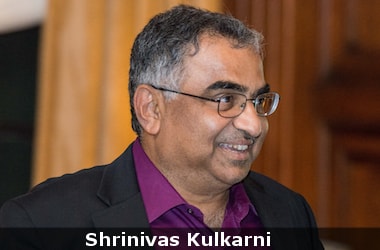 Indian scientist Shrinivas Kulkarni has won the prestigious Dan David prize as a recognition for his contributions made in the field of astronomy. Indian scientist Shrinivas Kulkarni has won the prestigious Dan David prize as a recognition for his contributions made in the field of astronomy.
Shrinivas Kulkarni, a professor of astrophysics and planetary science at California Institute of Technology in Pasadena, is a pioneer in the field of time-domain astrophysics.
He has been credited for building and conducting the Palomar Transient Factory, which is a large-area survey of the night sky that has turned up with thousands of stellar explosions.
Shrinivas Kulkarni would share the award with Andrej Udalski of the University of Warsaw and Neil Gehrels of NASA for their discoveries on time-domain astrophysics in the “Future” category of the prize.
With this award, he will join other prominent Indians who have won the Dan David prize like noted author Amitav Ghosh, music conductor Zubin Mehta and renowned chemist CNR Rao.
Dan David Prize: Know More
- The Dan David Foundation was established in 2000 by the late Dan David, an international businessman and philanthropist.
- Three Dan David prizes of $1 million each are awarded each year in the categories of “Past,” “Present” and “Future” to people who have made exemplary contributions to humanity in the field of sciences, humanities, or for their work in civil society.
- The recipients in the “Past” category are chosen from the field of history, archaeology, paleontology, biography, etc;.
- The recipients in the “Present” category are chosen from arts, media, policy, economics, etc.
- The recipients in the “Future” category are chosen from one of the exact or natural sciences. The prize mandates the laureates to donate 10% of their prize money to provide scholarships for graduate or post-graduate researchers in their respective fields.
|
▼ Navy, SAC sign MoU [05-17-17]
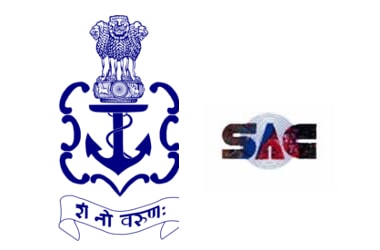 The Indian Navy and the Space Application Centre has signed a Memorandum of Understanding on Data Sharing and Scientific cooperation in the field of Meteorology and Oceanology. The Indian Navy and the Space Application Centre has signed a Memorandum of Understanding on Data Sharing and Scientific cooperation in the field of Meteorology and Oceanology.
As per the MoU, the scientific advancements and expertise achieved by SAC would be synergised into the Indian Naval efforts in order to keep the Indian Navy abreast with rapid developments that has taken place in the field of Environment Sciences and Satellite Data acquisition technology.
The MoU has further enhanced the already established collaboration between the two organisations.
The broad areas of cooperation under the MoU are:
- Sharing of non-confidential observational data for pre-launch sensor calibration and post launch satellite data validation,
- Operational use of SAC generated weather products,
provisioning expertise for installation of various satellite data processing modules at Naval METOC organisations, - Performing calibration and validation for ocean models,
- Transfer of technology to produce weather information, training on latest technology and sharing of subject matter experts between the organisations facilitating effective knowledge transfer.
SAC: Know More- Space Applications Centre (SAC) is one of the major centres of ISRO.
- It was established in the year 1972.
- It primarily focuses on the design of space-borne instruments for ISRO missions.
- It also develops applications of space technology and is headquartered in Ahmedabad, Gujarat
|
▼ N. Korea launches missile with nuclear warhead [05-16-17]
 North Korea indicated the missile it launched over the weekend was a new type of “medium long-range” ballistic rocket that can carry a heavy nuclear warhead. North Korea indicated the missile it launched over the weekend was a new type of “medium long-range” ballistic rocket that can carry a heavy nuclear warhead.
North Korean propaganda must be considered with wariness as Pyongyang has threatened for decades to reduce Seoul to a “sea of fire.”
This missile launch may mark another big advance toward the North’s goal of fielding a nuclear-tipped missile capable of reaching the US mainland.
This launch tested a new type of missile in Pyongyang’s arsenal.
The test is also an immediate challenge to South Korea’s new leader, Moon Jae-in, a liberal elected last week who expressed a desire to reach out to North Korea.
Pyongyang’s aggressive push to boost its weapons program also makes it one of the Trump administration’s most urgent foreign policy worries, though Washington has struggled to settle on a policy.
North Korea’s official Korean Central News Agency called the missile a “new ground-to-ground medium long-range strategic ballistic rocket,” and indicated the “Hwasong-12” was “capable of carrying a large, heavy nuclear warhead.”
The missile flew for half-an-hour and reached an unusually high altitude before landing in the Sea of Japan, the South Korean, Japanese and US militaries said.
The rocket, “newly designed in a Korean-style,” flew 787 kilometers (490 miles) and reached a maximum altitude of 2,111.5 kilometers (1,310 miles).
North Korea “verified the homing feature of the warhead under the worst re-entry situation and accurate performance of detonation system.”
North Korea is not thought to be able yet to make a nuclear warhead small enough to mount on a long-range missile.
|
▼ New Pneumococcal Conjugate vaccine launched [05-15-17]
 Minister for Health and Family Welfare J P Nadda has launched new Pneumococcal Conjugate Vaccine, PCV, for Pneumonia at Lal Bahadur Shastri Medical College Hospital in Mandi district of Himachal Pradesh. Minister for Health and Family Welfare J P Nadda has launched new Pneumococcal Conjugate Vaccine, PCV, for Pneumonia at Lal Bahadur Shastri Medical College Hospital in Mandi district of Himachal Pradesh.
The vaccine is a part of government’s Universal Immunization Programme (UIP).
Henceforth, the vaccine will be administered under routine immunization programme.
The vaccine would help in controlling pneumonia and reducing the child mortality rate.
In India, more than 1 lakh children die of pneumonia every year.
The vaccine will provide protection against 13 types of pneumococcal bacteria which results in pneumonia.
This is the 12th disease for which the Health Ministry has launched a vaccine.
The vaccine Pneumococcal Conjugate protects against Streptococcus pneumonia and diseases such as pneumonia, ear infections, sinus infections and meningitis.
Pneumococcal Conjugate Vaccine was first introduced in 2000.
The whole of Himachal Pradesh as well as six districts of Uttar Pradesh and seventeen districts of Bihar will be covered under the first phase of the immunisation programme.
PCV: Know More
- Pneumococcal conjugate vaccine (PCV) is a pneumococcal vaccine and a conjugate vaccine used to protect infants, young children, and adults against disease caused by the bacterium Streptococcus pneumoniae (the pneumococcus).
- There are currently three types of PCV available on the global market, which go by the brand names: Prevnar (called Prevenar in some countries), Synflorix and Prevnar 13.
- PVC protects against 13 bacteria related to pneumococcal infection.
|
▼ India to replace Maitri research station [05-12-17]
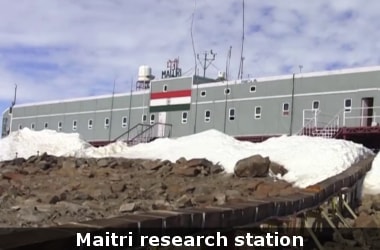 India has taken the decision to replace its Maitri research station in Antarctica with a new one in the next three to four years. India has taken the decision to replace its Maitri research station in Antarctica with a new one in the next three to four years.
India is poised to expand its research activity in the coldest continent and a new ship, with a special ice-cutting facility, will be procured for the purpose.
India is also drafting its own laws to safeguard its interest in Antarctica, as it is currently governed by international laws.
The Indian Antarctic Program is a multi-disciplinary, multi-institutional program under the control of National Centre for Antarctic and Ocean Research, Ministry of Earth Sciences, Government of India.
It was initiated in 1981 with the first Indian expedition to Antarctica.
The program gained global acceptance with India’s signing of the Antarctic Treaty and subsequent construction of the Dakshin Gangotri Antarctic research base in 1983.
Gangotri base was superseded by the Maitri research station from 1990.
Bharati is the newest base that was commissioned in 2015, constructed out of 134 shipping containers.
India has carried out over 30 scientific expeditions to the Antarctic as of 14 October 2010.
Maitri: Know More
- Maitri is India’s second permanent research station in Antarctica as part of the Indian Antarctic Programme.
- The name was suggested by the then PM Mrs Indira Gandhi
- The expedition left the shores of India on 03 Dec 1984.
- Work on the station was first started by the Indian Expedition which landed there in end Dec 1984, the team was led by Dr. B B Bhattacharya.
- It was built and finished in 1989, shortly before the first station Dakshin Gangotri was buried in ice and abandoned in 1990–91.
- Maitri is situated on the rocky mountainous region called Schirmacher Oasis.
- It is only 5 km away from Russian Novolazarevskaya Station.
|
▼ Now, turn any surface into a touchscreen [05-10-17]
 Scientists have developed a new technology that can turn any surface - including walls, furniture and steering wheels - into a touch screen using tools as simple as a can of spray paint. Scientists have developed a new technology that can turn any surface - including walls, furniture and steering wheels - into a touch screen using tools as simple as a can of spray paint.
The method is to apply electrically conductive coatings or materials to objects or surfaces, or to craft objects using conductive materials, researchers said.
By attaching a series of electrodes to the conductive materials, researchers from Carnegie Mellon University in the US showed they could use a well-known technique called electric field tomography to sense the position of a finger touch.
With the new technology dubbed Electrick, conductive touch surfaces can be created by applying conductive paints, bulk plastics or carbon-loaded film.
Electrick is both accessible to hobbyists and compatible with common manufacturing methods, such as spray coating, vacuum forming and casting/moulding, as well as 3D printing.
Like many touchscreens, Electrick relies on the shunting effect — when a finger touches the touchpad, it shunts a bit of electric current to ground.
By attaching multiple electrodes to the periphery of an object or conductive coating, researchers showed they could localise where and when such shunting occurs.
Electrick can detect the location of a finger touch to an accuracy of one centimetre, which is sufficient for using the touch surface as a button or slider.
|
▼ European XFEL: World's biggest X-ray Laser [05-9-17]
 The world’s biggest X-ray laser has generated its first beam of light, that will allow scientists to get a glimpse of new materials, drugs and chemical reactions at the atomic level. The world’s biggest X-ray laser has generated its first beam of light, that will allow scientists to get a glimpse of new materials, drugs and chemical reactions at the atomic level.
The 3.4-kilometre-long European XFEL, most of which is located in underground tunnels in Germany, will usher a new era of European research, according to scientists.
The biggest X-ray light has a wavelength of 0.8 nanometre - about 500 times shorter than that of visible light.
At first lasing, the laser had a repetition rate of one pulse per second, which will later increase to 27,000 per second.
The achievable laser light wavelength corresponds to the size of an atom, meaning that the X-rays can be used to make pictures and films of the nanocosmos at atomic resolution - such as of biomolecules, from which better understanding of the basis of illnesses or the development of new therapies could be developed.
The facility, to which many countries around the world contributed know-how and components, has passed its first big test with flying colours.
Scientists can now begin to direct the X-ray flashes with special mirrors through the last tunnel section into the experiment hall, and then step by step start the commissioning of the experiment stations.
The first laser light produced today with the most advanced and most powerful linear accelerator in the world marks the beginning a new era of research in Europe.
The European XFEL will provide scientists with the most detailed images of the molecular structure of new materials and drugs and novel live recordings of biochemical reactions.
The facility will enable research into chemical processes and catalytic techniques, with the goal of improving their efficiency or making them more environmentally friendly; materials research; or the investigation of conditions similar to the interior of planets.
The X-ray laser light of the European XFEL was generated from an electron beam from a superconducting linear accelerator, the key component of the X-ray laser.
|
▼ World's last living dinosaur Chenanisaurus barbaricus discovered [05-8-17]
 The fossil of one of the last living African dinosaur was discovered in a phosphate mine in northern Morocco. The fossil of one of the last living African dinosaur was discovered in a phosphate mine in northern Morocco.
The species, Chenanisaurus barbaricus, is reportedly one of the last ones to have survived on Earth before an asteroid strike wiped them out 66 million years ago
The project was carried out as a part of an international scientific collaboration that aims to conserve Morocco’s rich fossil heritage by helping create and study the country’s palaeontology collections.
The fossil study is being led by Milner Centre for Evolution at the University of Bath.
Its analysis suggests that a distinct dinosaur fauna evolved in Africa following the breakup of the Gondwana supercontinent in the middle of the Cretaceous period.
The new species is understood to be the smaller African contemporary of the North American T-Rex.
Almost nothing is known about the dinosaurs that lived in Africa at the end of the Cretaceous period 66 million years ago, just before their extinction.
Most of the fossils have been discovered from marine rocks.
The study revealed that the fragment belonged to an abelisaur, two-legged predators like T. rex and other tyrannosaurs with a shorter snout and tinier arms.
The species were known to be the top predators at the end of the Cretaceous period in Africa, South America, India, and Europe.
Unlike the abelisaurs, who had very short arms, the newly discovered dinosaur- Chenanisaurus barbaricus- stood on two legs and had stumpy arms.
The study of the fossil’s worn-out teeth reveals that it was a predator and unlike the partially feathered T. rex, Chenanisaurus had only scales and its brain was much smaller and its face, shorter and deeper.
Dinosaurs: Know More
- Dinosaurs are known to have lived between 230 and 65 million years ago, a period that is known as the Mesozoic Era.
- The period is many million years before the first modern humans, Homo sapiens, appeared.
- Scientists divide the Mesozoic Era into three periods: the Triassic, Jurassic and Cretaceous.
- The Cretaceous Period was the last and longest period of the Mesozoic Era.
- It began 145 million years ago and ended 66 million years ago, lasting for approximately 79 million years. It followed the Jurassic period and ended with the extinction of the dinosaurs.
- The period may have seen more dinosaurs than ever before.
- Some of the dinosaur species that evolved during this time include Triceratops, Centrosaurus, armoured Ankylosaurus and the large carnivore Tyrannosaurus.
|
▼ IIT Madras scientists use red pomegranate, turmeric to produce white light [05-8-17]
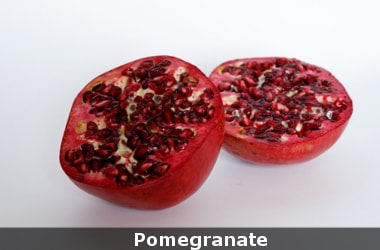 IIT Madras has won the BIRAC Gandhian Young Technological Innovation (GYTI) Award 2017 for its work on producing white light emission using natural extracts. IIT Madras has won the BIRAC Gandhian Young Technological Innovation (GYTI) Award 2017 for its work on producing white light emission using natural extracts.
Scientists from the Department of Chemistry, IIT Madras used a mixture of two natural extracts - red pomegranate and turmeric - to produce white light emission.
The researchers used a simple and environment-friendly procedure to extract dyes from pomegranate and turmeric.
While polyphenols and anthocyanins present in red pomegranate emit at blue and orange-red regions of the wavelength respectively, curcumin from turmeric emit at the green region of the wavelength.
White light emission is produced when red, blue and green mix together.
This is probably the first time white light emission has been generated using low-cost, edible natural dyes.
By changing the concentration of the two extracts the researchers were able to get different colour temperature (tunability).
When the two extracts and irradiate it with UV radiation at 380 nm, scientists observed energy transfer (FRET mechanism) taking place from polyphenols to curcumin to anthocyanins, which helps to get perfect white light emission.
For FRET mechanism to take place there must be spectral overlap between the donor and acceptor.
In this case, there is a perfect overlap of emission of polyphenols with absorption by curcumin so the energy from polyphenols is transferred to curcumin.
Since there is also a perfect overlap of emission of curcumin with absorption by anthocyanin, the energy of curcumin is transferred to anthocyanin.
As a result of this energy transfer from one dye to the other, when the extract is irradiated with UV light at 380 nm (blue region of the wavelength), the polyphenols emit in the blue region of the wavelength and transfers its energy to curcumin.
The excited curcumin emits in the green region of the wavelength and transfers its energy to anthocyanin, which emits light in the red region of the wavelength.
Scientists carbon nanoparticles using pomegranate and to their surprise it was producing fairly green emission.
So instead of using turmeric to get green wavelength, the researchers used carbon nanoparticles made from pomegranate extract. “
Though this natural mixture of dyes can be used in a wide variety of applications such as tunable laser, LEDs, white light display, much work needs to be done in terms of photostability and chemical stability before it becomes ready for translation.
Biosystems have an inherent tendency to breakdown and so this has to be addressed.
|
▼ World’s fastest film camera can capture light [05-8-17]
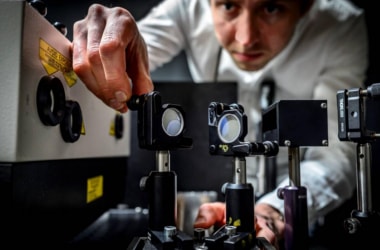 World’s fastest film camera can ‘capture’ light. World’s fastest film camera can ‘capture’ light.
As per Einstein’s theory, nothing can travel faster than the speed of light in a vacuum that makes it difficult to capture.
Now researchers at Lund University in Sweden have built the world’s fastest film camera that is capable of taking five trillion images per second.
This means an image every 0.2 trillionths of a second.
In other words, the camera is fast enough to visualize the movement of light or capture molecular processes.
The camera could be used to observe extremely rapid natural processes and reactions in chemistry, physics, biology and biomedicine that until now have not been captured on film.
The researchers exposed an object to be filmed to brief flashes of laser light, which were reflected by the object.
The new technology called Frequency Recognition Algorithm for Multiple Exposures (FRAME) is based on an innovative algorithm.
It instead captures several coded images in one picture and later sorts them into a video sequence.
This method took four separate images per frame instead of taking images one by one in a sequence, like other high-speed cameras.
|
▼ ISRO launches India's first solar hybrid electric car [05-5-17]
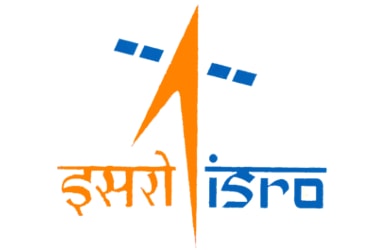 ISRO demonstrated its solar hybrid electric car and there's a strong reason behind working on it. ISRO demonstrated its solar hybrid electric car and there's a strong reason behind working on it.
Vehicles using fossil fuels persistently bring serious problems to environment and life.
In this perspective, Solar and Electrical energy based hybrid vehicles provide the most effective and viable long-term solution by using renewable energy sources for mobility.
Vikram Sarabhai Space Centre (VSSC), ISRO, Thiruvananthapuram, demonstrated the running of a solar hybrid electric car using in-house expertise and resources within ISRO.
Considerations involved the right solar panel to suit the roof top of car, a super-capacitor to meet the high peak current of beyond 100 A level, an integral gear box to augment the performance of the Brushless DC (BLDC) motor.
It also involved control electronics for the battery and solar panel interface and drive electronics for running the motor in a smooth way.
The biggest one of course was the conversion of the internal combustion engine (ICE) based vehicle, which was a Maruti Suzuki Omni, to fit in with the electric motor.
The Brushless motor had to be modified to improve torque
To drive the car, energy was supplied to the vehicle by energy density Lithium ion batteries connected across high power density super-capacitors.
The battery delivered the sustained energy requirement while the super-capacitor supported the peak power demand during high torque conditions.
This arrangement of power sharing helped in enhancing the life of power-restricted batteries.
Energy was supplied to the vehicle by energy density Lithium ion batteries.
A solar panel fitted on rooftop of the car charges the battery by absorbing the sunlight.
How it Works
- This electrical energy needed to be converted to mechanical energy to drive the wheels.
- This was achieved by integrating an efficient power conversion module between energy system and electric motor.
- The usage of a Brushless type motor helped in improving the torque and reducing energy input while also helping in weight savings.
- Concerted efforts were made to ensure that the associated safety aspects are not compromised while combining various active subsystems of different behaviour for a focused objective.
|
▼ China set to compete with Wikipedia! [05-5-17]
 China has hired more than 20,000 people to build the country's online version of national encyclopaedia to compete with Wikipedia. China has hired more than 20,000 people to build the country's online version of national encyclopaedia to compete with Wikipedia.
The Chinese Wikipedia will be launched in 2018 and will feature 300,000 entries at about 1,000 words each.
The Wikipedia of China will be created by select scholars from state-run universities unlike the original Wikipedia that is openly editable by volunteers.
Currently, Wikipedia is available in China but some of its contents are blocked.
The Encyclopaedia of China is not a book but a Great Wall of culture, according to the project's editor in chief.
The Encyclopaedia of China already exists in paper form that was first published in 1993. Its second edition was released in 2012.
Last week, Turkish authorities banned access to Wikipedia in the country without giving any particular reasons.
Aiming to provide better information about the country than what was already available on the Wikipedia, Russia in 2014 announced plans for an alternative version of the online encyclopaedia.
|
▼ Geologists discover reason behind Blood Falls of Antarctica [05-3-17]
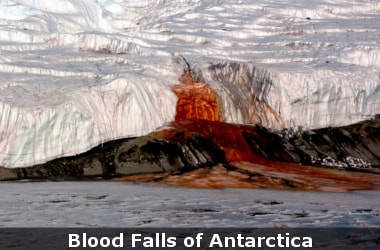 Geologists have finally uncovered the truth behind the seemingly mysterious ‘Blood Falls’ of Antarctica. Geologists have finally uncovered the truth behind the seemingly mysterious ‘Blood Falls’ of Antarctica.
Located in the McMurdo Dry Valleys, the falls were discovered by researchers in 1911 when it poured off the cliff in the Great Taylor glacier.
The bright red colour of the water was attributed to discolouration caused by red algae.
But now, research is proposing a new solution.
According to the research, the red colour is a product of oxidisation of iron that takes place when iron minerals dissolve in high-density salt water or brine.
When this water comes in contact with oxygen, a process of oxidation ensues which imparts the bright red colour. (This is also the same process by which iron rusts when exposed to air.)
The research team used imaging from underneath the glacier using a technique called radio-echo sounding or RES.
This is important because saline water indicates variation in densities that were ultimately used to uncover the process of oxidation.
It was found that the brine, which was from a lake that flows underneath the Great Taylor glacier, takes 1.5 million years before finally reaching the Blood Falls.
The brine is discovered to have picked up minerals from underlying hard bedrocks and gushes forth off the surface of the glacier through fissures.
Water containing soluble impurities such as salt freezes at a much lower temperature than fresh water.
The frozen water contains a certain amount of latent heat that can keep the river flowing.
This means that while the surface may remain frozen, the underlying brine remains liquid. (It is the same principle based on which people salt streets during the winter before the onset of a storm.)
The brine remains liquid within the subglacial and englacial environments through latent heat of freezing coupled with elevated salt content.
The findings suggest that cold glaciers could support freshwater hydrologic systems through localized warming by latent heat alone.
Finally, the pressure of the solid block of ice above forces water through an intricate channel of fissures which culminate in a red river that falls off Great Taylor.
Another interesting insight is the presence of microbial organisms that inhabit these saline rivers with low oxygen content and survive eons in isolation. It can serve as evidence for adaptation in harsh environments.
|
▼ First automatic weather station set up in Maharashtra's Nagpur [05-2-17]
 Maharashtra chief minister Devendra Fadnavis has inaugurated the state’s first automatic weather station at Dongargaon in Nagpur. Maharashtra chief minister Devendra Fadnavis has inaugurated the state’s first automatic weather station at Dongargaon in Nagpur.
The state government proposes to install around 2,065 such weather stations across the state on a public private partnership (PPP) mode in this year and 1,000 in next year.
The weather stations will help in measuring the wind direction, wind speed, air temperature, relative humidity and record amount of rainfall.
The information obtained by the weather stations would be shared among the farmers by making them available on Mahavedh portal (Maharashtra agriculture weather information network) as well as on the mobile application of Skymet.
Weather forecast firm Skymet Weather Private Ltd will be establishing up these weather stations.
The farmers of the state can make use of the information to manage sowing in a much better and planned way as per the weather conditions.
These weather stations are significant because the IMD forecast is limited to only four zones.
The weather related information is not made available by the IMD at the level of taluks. But, the AWS will provide forecast up to taluka level.
As one weather station will be installed for an area of around 12×12 km, micro-level weather forecasts will be possible.
Additionally, the digital kiosks will be set-up in every Gram Panchayat to disburse weather related information and expert advice on crop pattern to the farmers.
During Phase 1, information will be shared using SMS. In the second phase, half hourly updates will be provided to all the Gram Panchayats.
The sensors of the AWS will be able to record important parameters relevant for agriculture like temperature, relative humidity, wind speed and direction, rainfall, solar radiation, leaf wetness, soil moisture and temperature and atmospheric pressure and evapotranspiration.
The state government plans to use the data provided by the AWS to prepare location-specific agriculture advisories, better disaster management, design crop insurance schemes and establish a weather database bank.
|
▼ SpaceX launches spy satellite in US [05-2-17]
 SpaceX has launched a top-secret spy satellite for the US government. SpaceX has launched a top-secret spy satellite for the US government.
The unmanned Falcon 9 rocket lifted off May 1, 2017 from its NASA-leased pad at Kennedy Space Center in Florida.
It hoisted a classified satellite for the National Reconnaissance Office.
Several minutes into the flight, the first stage booster timed for a touchdown at Cape Canaveral Air Force Station. SpaceX strives to return most of its first-stage boosters for reuse.
This was the fourth SpaceX booster landing at Cape Canaveral; even more have landed on an ocean platform.
The company's first recycled rocket flew last month.
SpaceX: Know More
- CEO: Elon Musk (2002–)
- Founder: Elon Musk
- Founded: 2002
- Headquarters: Hawthorne, California, United States
- Number of employees: ~6,000; (April 2017)
- Type of business: Privately held company
|
▼ China launches world’s largest amphibious aircraft [05-2-17]
China has successfully conducted the maiden test glide of its first amphibious aircraft said to be the largest in the world, from the southern Chinese city of Zhuhai.
The glide test was conducted on 29th April, 2017. As per the China Aviation Industry General Aircraft Co Ltd, the aircraft is said to be the world’s largest.
The 37-meter AG600 with a wingspan of 38.8 meters, has a maximum take-off weight of 53.5 tonnes.
It can collect 12 tonnes of water in 20 seconds, and transport up to 370 tonnes of water on a single tank of fuel.
With excellent manoeuvrability and a relatively wide search scope range, the AG600 will be mainly used for maritime rescue, forest fire fighting, marine environment monitoring and protection.
AG600 would embark on its maiden flight over land in late May and on water in the second-half of 2017.
The aircraft developer has received orders for 17 AG600s.
Chinese Armed Forces: Know More - The Chinese People’s Liberation Army (PLA) is the armed forces of the Communist Party of China (CPC) and the People’s Republic of China.
- The PLA consists of five professional service branches: the Ground Force, Navy, Air Force, Rocket Force, and the Strategic Support Force.
- The PLA is the world’s largest military force, with a strength of approximately 2,285,000 personnel, 0.18% of the country’s population.
- In September 2015, Xi Jinping, the General Secretary of the Communist Party of China and the commander-in-chief of the PLA, announced a reduction of the number of military personnel by 300,000.
- Its symbol is a roundel with a red star.
|
▼ China, EU planning first moon village [05-2-17]
China and Europe are planning to build the first-ever “moon village” that could serve as a launching pad for deep space missions such as one to Mars, or even as a spot for space tourism and lunar mining.
Representatives of the Chinese and European space agencies have discussed collaborating on a moon-base and other possible joint endeavours.
The plan was first revealed by Tian Yulong, the secretary general of China’s space agency. The European Space Agency (ESA), confirmed the discussions.
ESA chief Johann-Dietrich Worner has described its proposed “moon village” as a potential international launching pad for future deep space missions, such as to Mars, and a chance to develop tourism or even lunar mining.
ESA: Know More - Headquarters: Paris, France
- Budget: 5.75 billion EUR (2017)
- Primary spaceport: Guiana Space Centre
- Acronym: ESA; ASE
- CEO: Johann-Dietrich Wörner (1 Jul 2015)
- Founded: 30 May 1975, Europe
- Official language(s): English, French and German
|
▼ Now, IIT Roorkee makes solar cells from jamun fruit! [05-2-17]
Scientists at IIT Roorkee have used the juicy, delectable Indian summer fruit Jamun to create inexpensive and more efficient solar cells.
Researchers used naturally occurring pigment found in jamun as an inexpensive photosensitiser for Dye Sensitised Solar Cells (DSSCs) or Gratzel cells.
Gratzel cells are thin film solar cells.
These composed of a porous layer of titanium dioxide (TiO2) coated photoanode.
This is a layer of dye molecules that absorbs sunlight.
Also used were an electrolyte for regenerating the dye, and a cathode.
These components form an in between-like structure with the dye molecule or photosensitizer playing a pivotal role through its ability to absorb visible light.
The dark colour of jamun and abundance of jamun trees in IIT campus clicked the idea that it might be useful as a dye in the typical Dye Sensitised Solar Cells (DSSC).
Researchers extracted dyes from jamun using ethanol. They also used fresh plums and black currant, along with mixed berry juices which contain pigments that give characteristic colour to jamun.
The mixture was then centrifuged and decanted. The extracted coloured pigment called anthocyanin was used as a sensitiser.
Natural pigments are way economical in comparison to regular Ruthenium-based pigments and scientists are optimising to improve the efficiency. The increasing pressure on fossil fuels and concern of global warming has inspired continuous search for alternate energy,
India aims to deliver on the country’s pledge to build up a 40 per cent share of non-fossil fuel capacity in the power sector by 2030, researchers said.
There is a large social need for renewable energy especially solar energy. The lab is actively engaged in low cost high efficiency solar cells production.
The simplicity and cost effectiveness of the overall fabrication process, widespread availability of fruits and juices, and ease of extraction of anthocyanin dyes render them novel and inexpensive candidates for solar cells application.
Jamun: Know More - Syzygium cumini, known as jambul, jambolan, jamblang or jamun, is an evergreen tropical tree.
- It is in the flowering plant family Myrtaceae.
- Syzygium cumini is native to the Indian Subcontinent and adjoining regions of Southeast Asia.
- The species ranges across India, Bangladesh, Pakistan, Nepal, Sri Lanka, Malaysia, the Philippines, and Indonesia.
- USDA grew the first jamun tree in the US in Florida.
|
▼ CSIR scientists find novel approach to drug discovery [05-2-17]
In a completely different approach to drug discovery, Delhi’s CSIR-Institute of Genomics and Integrative Biology (CSIR-IGIB) has used a combination of approaches to predict potential drug targets in Mycobacterium tuberculosis.
This is a TB-causing bacteria.
The novel method not only helps in speeding up drug discovery by finding potential, non-toxic drug targets but will also cost far less by reducing the chances of failure.
The results were published in the journal Scientific Reports.
Conventionally, drug discovery was never looked at from a systems biology point of view.
The approach the scientists used was rather unconventional, aimed at finding targets first based on evolutionary conservation principle in an organism,
Based on a previous study that used the Systems Biology Spindle Map (SBSM) approach, the team was able to identify 890 novel, non-toxic gene drug targets.
Using computational approaches, the potential drug targets were reduced to 116 essential genes; these 116 genes are so vital that any inhibition would kill the bacteria.
In order to identify drug targets with the least likelihood of side effects, the 116 essential genes were compared with the human genome and human microbiome at the sequence level to identify genes that did not have any similarity (homology) with human genome sequences.
Of the 116 genes, 104 were found to have no similarity with the human genome sequences, meaning any drug developed targeting these 104 genes will only target the TB bacteria and not cause any harm to human cells.
The potential drug targets were further shortlisted to 33 genes.
The presence or absence of mutations in any of the 33 genes was evaluated using the Genome-wide Mycobacterium tuberculosis Variation (GMTV) database.
The genes which are essential for bacteria never undergo any mutations as that would be lethal for their survival.
The crystal structure, which is essential for carrying out drug discovery process, was available for 15 of the 33 targets.
Once scientists have the targets and have structures of these targets then can tailor-make molecules to inhibit even MDR-TB and XDR-TB,.
The team has already carried out druggability assessment (to find out if the targets have certain properties for a drug to bind to receptors) for all the 33 gene targets.
Most of the 33 genes were found to be highly druggable validating the study.
There is a need for drug discovery to move from Wright brothers’ era of trial and error method. The trial and error approach is slow and too expensive.
All the genes, targets and even ligands will be in open source so anyone can develop new drug molecules.
|
▼ Scientists find lakes, streams on Antarctica ice sheet [05-2-17]
Scientists have found that vast lakes and streams are widespread on the surface of Antarctica's ice sheets.
This may accelerate its contribution to the rise in sea-level as it moves surface water across its ice sheets onto ice shelves.
Researchers used aerial photography and satellite imagery to find that melt-water moves vast distances across the surface of the ice sheets onto ice shelves.
Huge lakes have been forming on the surface of Antarctica since at least the 1940s and extensive networks of streams have been draining water onto vulnerable ice shelves that are prone to collapse.
Scientists previously believed that the drainage of surface water, known as melt-water, was a rarity in Antarctica.
Ice shelves, which are floating parts of ice sheets, are prone to collapse when water flows into their cracks and crevasses.
If melted completely, Antarctica's ice sheets contain enough water to raise global sea levels by around 58 metres.
|
▼ South Asia satellite to be launched on May 5, 2017 [05-2-17]
The South Asia Satellite will be launched on May 5, India’s “priceless gift” to its neighbours as part of the 'sabka sath, sabka vikas' concept.
Seven out of eight SAARC countries are a part of the project which Pakistan refused to join as it did not want the "gift" from India.
The concept of 'sabka sath, sabka vikas' is not confined to India but is relevant globally too, especially in the context of the neighbourhood.
The benefits of this satellite will go a long way in meeting the developmental needs of the countries participating in this project.
This is an appropriate example of India's commitment towards South Asia. The satellite of South Asia will help in the overall development of the entire region
The benefits will be in the partner countries in areas of mapping of natural resources, tele-medicine, education, IT connectivity and people-to-people links, he said.
These countries, besides India, are Nepal, Bangladesh, Bhutan, Sri Lanka, Maldives and Afghanistan.
Modi had made a unilateral proposal of India launching the satellite whose data would be shared with the eight SAARC countries for their development.
Initially, it was to be named as ‘SAARC Satellite’ but its name was changed to South Asia Satellite after Pakistan refused to join the project.
Basically, the satellite is meant for providing communication and disaster support, connectivity among the countries of South Asia region.
It will provide a significant capability to each of the participating countries in terms of DTH, certain VSAT capacity plus linking among the states for both disaster information transfer and also in terms of library type of things.
|
▼ ISRO to launch 5 communication satellites by 2017 end [05-2-17]
The Indian Space Research Organisation (ISRO) is going to launch five communication satellites by the end of 2017.
The main aim behind the launch is to improve the communication system within the country.
The specific use of the satellites would be to improve the number of available transponders for communications.
The move is expected to significantly enhance India’s communication capability.
An overview of the number of satellites launched by the space organisation and the purpose of each satellite in the areas of disaster management, weather forecasting, space exploration, education, agriculture and geo-spatial applications was also provided.
India is the only country to achieve the feat of having a large number of satellites.
ISRO along with the government has made it mandatory for all aircrafts to have a GPS-aided Geo Augmented Navigation (GAGAN) system by 2019 to ensure safety and precision landing.
Apart from this, ISRO plans to make an inventory and site management plan for 4000 heritage sites in India.
The organisation also helped India break the record for launching most satellites from a single rocket by launching 104 satellites in one go in February 2017.
GAGAN: Know More - The GPS Aided GEO Augmented Navigation (GAGAN) is an implementation of a regional satellite-based augmentation system (SBAS) by the Indian government.
- It is a system to improve the accuracy of a GNSS receiver by providing reference signals.
- Project cost?: ?INR 7.74 billion (US$120 million)
- Fully operational by?: ?2013-14
- Launched?: ?2011-2012
|